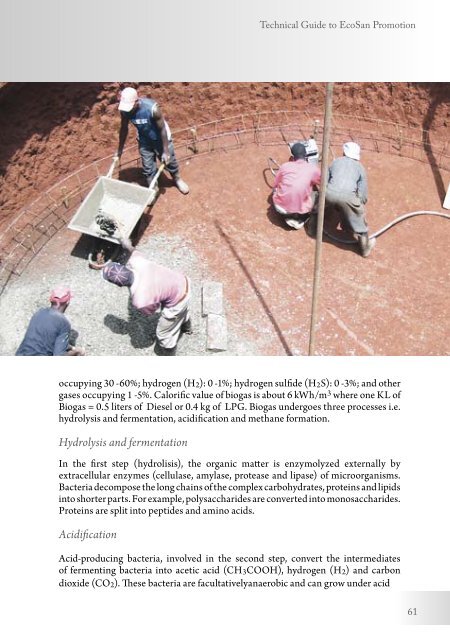Technical Guide to EcoSan Promotion
Technical Guide to EcoSan Promotion
Technical Guide to EcoSan Promotion
Create successful ePaper yourself
Turn your PDF publications into a flip-book with our unique Google optimized e-Paper software.
<strong>Technical</strong> <strong>Guide</strong> <strong>to</strong> <strong>EcoSan</strong> <strong>Promotion</strong><br />
occupying 30 -60%; hydrogen (H2): 0 -1%; hydrogen sulfide (H2S): 0 -3%; and other<br />
gases occupying 1 -5%. Calorific value of biogas is about 6 kWh/m 3 where one KL of<br />
Biogas = 0.5 liters of Diesel or 0.4 kg of LPG. Biogas undergoes three processes i.e.<br />
hydrolysis and fermentation, acidification and methane formation.<br />
Hydrolysis and fermentation<br />
In the first step (hydrolisis), the organic matter is enzymolyzed externally by<br />
extracellular enzymes (cellulase, amylase, protease and lipase) of microorganisms.<br />
Bacteria decompose the long chains of the complex carbohydrates, proteins and lipids<br />
in<strong>to</strong> shorter parts. For example, polysaccharides are converted in<strong>to</strong> monosaccharides.<br />
Proteins are split in<strong>to</strong> peptides and amino acids.<br />
Acidification<br />
Acid-producing bacteria, involved in the second step, convert the intermediates<br />
of fermenting bacteria in<strong>to</strong> acetic acid (CH3COOH), hydrogen (H2) and carbon<br />
dioxide (CO2). These bacteria are facultativelyanaerobic and can grow under acid<br />
61

















